Page 113 of 230
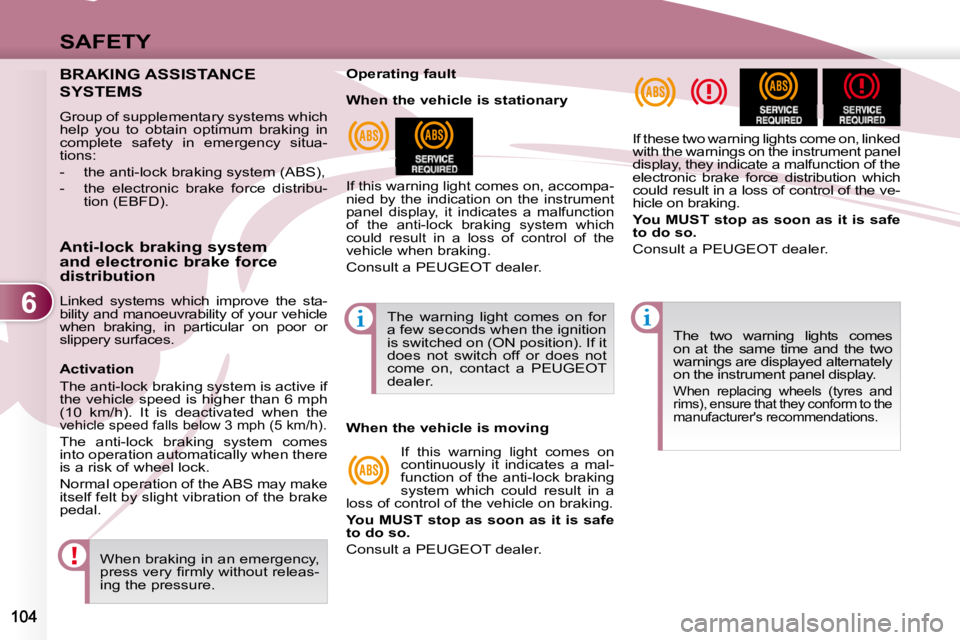
6
SAFETY
BRAKING ASSISTANCE
SYSTEMS
Group of supplementary systems which
help you to obtain optimum braking in
complete safety in emergency situa-
tions:
- the anti-lock braking system (ABS),
- the electronic brake force distribu-tion (EBFD).
When braking in an emergency,
�p�r�e�s�s� �v�e�r�y� �fi� �r�m�l�y� �w�i�t�h�o�u�t� �r�e�l�e�a�s�-
ing the pressure. The two warning lights comes
on at the same time and the two
warnings are displayed alternately
on the instrument panel display.
When replacing wheels (tyres and
rims), ensure that they conform to the
manufacturer's recommendations.
Operating fault
If this warning light comes on, accompa-
nied by the indication on the instrument
panel display, it indicates a malfunction
of the anti-lock braking system which
could result in a loss of control of the
vehicle when braking.
Consult a PEUGEOT dealer.
If these two warning lights come on, linked
with the warnings on the instrument panel
display, they indicate a malfunction of the
electronic brake force distribution which
could result in a loss of control of the ve-
hicle on braking.
You MUST stop as soon as it is safe
to do so.
Consult a PEUGEOT dealer.
Anti-lock braking system
and electronic brake force
distribution
Linked systems which improve the sta-
bility and manoeuvrability of your vehicle
when braking, in particular on poor or
slippery surfaces. The warning light comes on for
a few seconds when the ignition
is switched on (ON position). If it
does not switch off or does not
come on, contact a PEUGEOT
dealer.
When the vehicle is stationary
When the vehicle is moving
If this warning light comes on
continuously it indicates a mal-
function of the anti-lock braking
system which could result in a
loss of control of the vehicle on braking.
You MUST stop as soon as it is safe
to do so.
Consult a PEUGEOT dealer.
Activation
The anti-lock braking system is active if
the vehicle speed is higher than 6 mph
(10 km/h). It is deactivated when the
vehicle speed falls below 3 mph (5 km/h).
The anti-lock braking system comes
into operation automatically when there
is a risk of wheel lock.
Normal operation of the ABS may make
itself felt by slight vibration of the brake
pedal.
Page 114 of 230
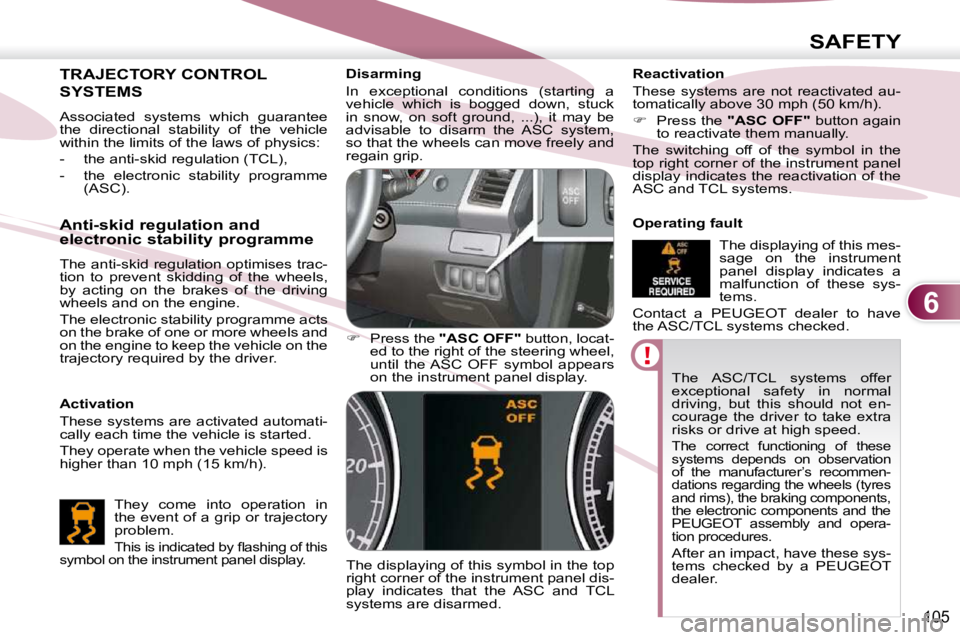
6
SAFETY
105
The ASC/TCL systems offer
exceptional safety in normal
driving, but this should not en-
courage the driver to take extra
risks or drive at high speed.
The correct functioning of these
systems depends on observation
of the manufacturer’s recommen-
dations regarding the wheels (tyres
and rims), the braking components,
the electronic components and the
PEUGEOT assembly and opera-
tion procedures.
After an impact, have these sys-
tems checked by a PEUGEOT
dealer.
Disarming
In exceptional conditions (starting a
vehicle which is bogged down, stuck
in snow, on soft ground, ...), it may be
advisable to disarm the ASC system,
so that the wheels can move freely and
regain grip.
� Press the "ASC OFF" button, locat-
ed to the right of the steering wheel,
until the ASC OFF symbol appears
on the instrument panel display.
The displaying of this symbol in the top
right corner of the instrument panel dis-
play indicates that the ASC and TCL
systems are disarmed. Reactivation
These systems are not reactivated au-
tomatically above 30 mph (50 km/h).
� Press the "ASC OFF" button again
to reactivate them manually.
The switching off of the symbol in the
top right corner of the instrument panel
display indicates the reactivation of the
ASC and TCL systems.
Operating fault
The displaying of this mes-
sage on the instrument
panel display indicates a
malfunction of these sys-
tems.
Contact a PEUGEOT dealer to have
the ASC/TCL systems checked.
TRAJECTORY CONTROL
SYSTEMS
Activation
These systems are activated automati-
cally each time the vehicle is started.
They operate when the vehicle speed is
higher than 10 mph (15 km/h).
Anti-skid regulation and
electronic stability programme
The anti-skid regulation optimises trac-
tion to prevent skidding of the wheels,
by acting on the brakes of the driving
wheels and on the engine.
The electronic stability programme acts
on the brake of one or more wheels and
on the engine to keep the vehicle on the
trajectory required by the driver.
They come into operation in
the event of a grip or trajectory
problem.
�T�h�i�s� �i�s� �i�n�d�i�c�a�t�e�d� �b�y� �fl� �a�s�h�i�n�g� �o�f� �t�h�i�s�
symbol on the instrument panel display.
Associated systems which guarantee
the directional stability of the vehicle
within the limits of the laws of physics:
- the anti-skid regulation (TCL),
- the electronic stability programme (ASC).
Page 115 of 230
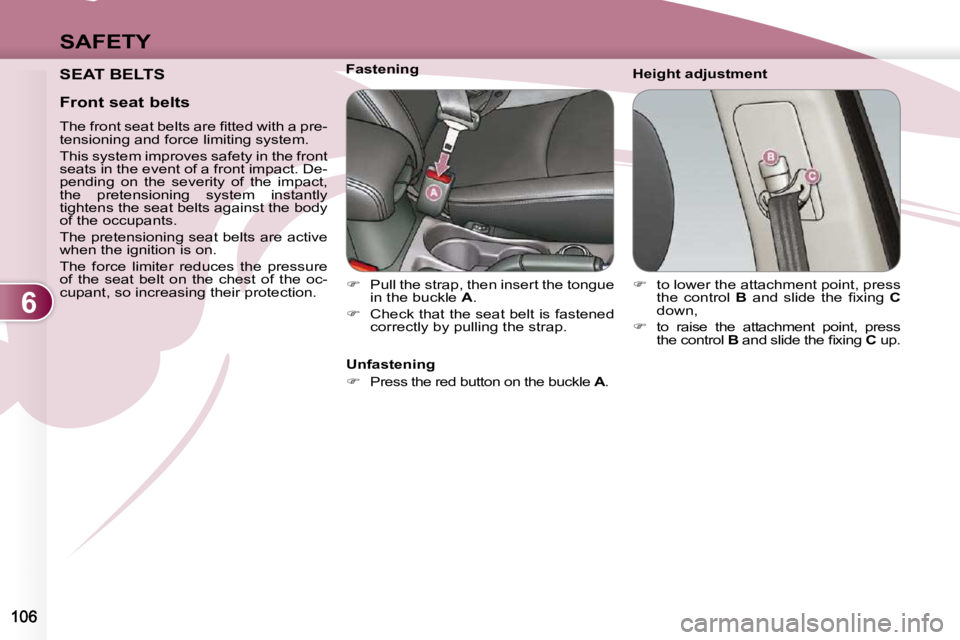
6
SAFETY
SEAT BELTS Height adjustment
Fastening
� Pull the strap, then insert the tongue
in the buckle A .
� Check that the seat belt is fastened
correctly by pulling the strap.
� to lower the attachment point, press
the control B� � �a�n�d� �s�l�i�d�e� �t�h�e� �fi� �x�i�n�g� � C
down,
� to raise the attachment point, press
the control B� � �a�n�d� �s�l�i�d�e� �t�h�e� �fi� �x�i�n�g� � C up.
Unfastening
� Press the red button on the buckle A .
Front seat belts
� � �T�h�e� �f�r�o�n�t� �s�e�a�t� �b�e�l�t�s� �a�r�e� �fi� �t�t�e�d� �w�i�t�h� �a� �p�r�e�-
tensioning and force limiting system.
This system improves safety in the front
seats in the event of a front impact. De-
pending on the severity of the impact,
the pretensioning system instantly
tightens the seat belts against the body
of the occupants.
The pretensioning seat belts are active
when the ignition is on.
The force limiter reduces the pressure
of the seat belt on the chest of the oc-
cupant, so increasing their protection.
Page 116 of 230
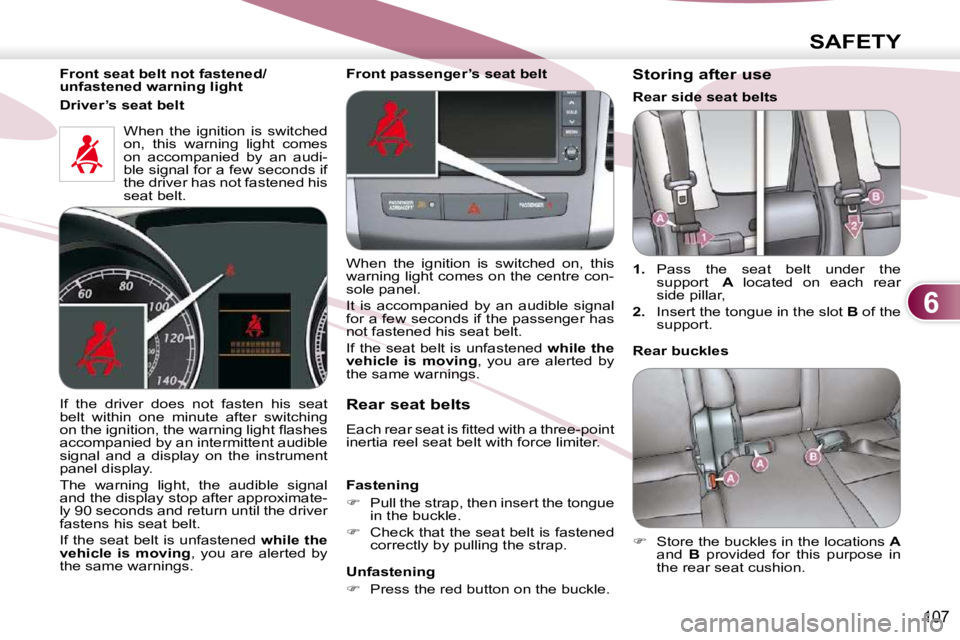
6
SAFETY
107
Front seat belt not fastened/
unfastened warning light When the ignition is switched
on, this warning light comes
on accompanied by an audi-
ble signal for a few seconds if
the driver has not fastened his
seat belt.
Rear seat belts
� �E�a�c�h� �r�e�a�r� �s�e�a�t� �i�s� �fi� �t�t�e�d� �w�i�t�h� �a� �t�h�r�e�e�-�p�o�i�n�t�
inertia reel seat belt with force limiter.
Fastening
� Pull the strap, then insert the tongue
in the buckle.
� Check that the seat belt is fastened
correctly by pulling the strap.
Unfastening
� Press the red button on the buckle.
If the driver does not fasten his seat
belt within one minute after switching
�o�n� �t�h�e� �i�g�n�i�t�i�o�n�,� �t�h�e� �w�a�r�n�i�n�g� �l�i�g�h�t� �fl� �a�s�h�e�s�
accompanied by an intermittent audible
signal and a display on the instrument
panel display.
The warning light, the audible signal
and the display stop after approximate-
ly 90 seconds and return until the driver
fastens his seat belt.
If the seat belt is unfastened
while the
vehicle is moving , you are alerted by
the same warnings. Storing after use
1. Pass the seat belt under the
support A located on each rear
side pillar,
2. Insert the tongue in the slot B of the
support.
Rear buckles
� Store the buckles in the locations A
and B provided for this purpose in
the rear seat cushion.
Front passenger’s seat belt
When the ignition is switched on, this
warning light comes on the centre con-
sole panel.
It is accompanied by an audible signal
for a few seconds if the passenger has
not fastened his seat belt.
If the seat belt is unfastened
while the
vehicle is moving , you are alerted by
the same warnings.
Driver’s seat belt
Rear side seat belts
Page 117 of 230
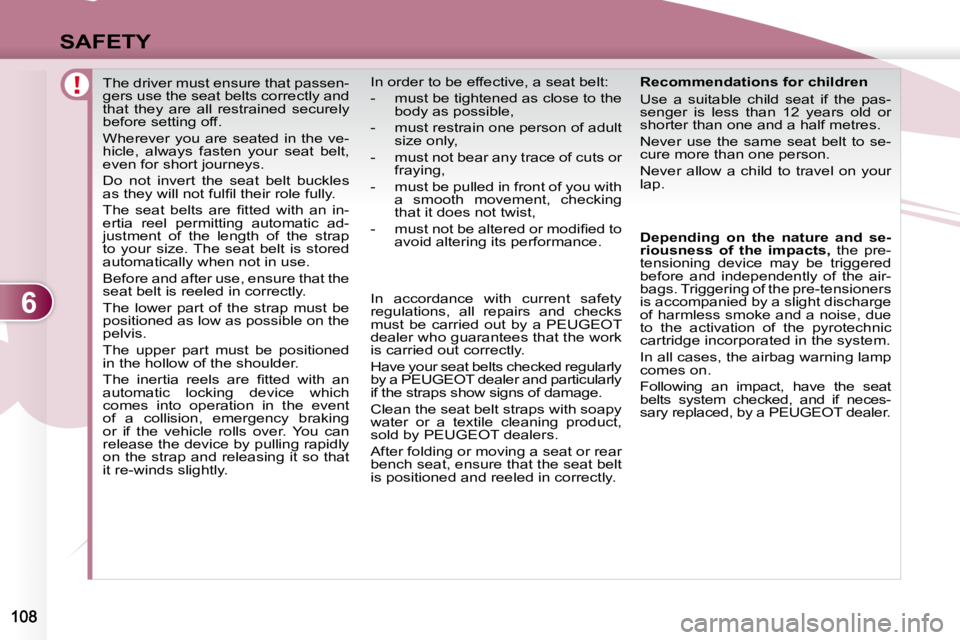
6
SAFETY
The driver must ensure that passen-
gers use the seat belts correctly and
that they are all restrained securely
before setting off.
Wherever you are seated in the ve-
hicle, always fasten your seat belt,
even for short journeys.
Do not invert the seat belt buckles
�a�s� �t�h�e�y� �w�i�l�l� �n�o�t� �f�u�l�fi� �l� �t�h�e�i�r� �r�o�l�e� �f�u�l�l�y�.�
� �T�h�e� �s�e�a�t� �b�e�l�t�s� �a�r�e� �fi� �t�t�e�d� �w�i�t�h� �a�n� �i�n�-
ertia reel permitting automatic ad-
justment of the length of the strap
to your size. The seat belt is stored
automatically when not in use.
Before and after use, ensure that the
seat belt is reeled in correctly.
The lower part of the strap must be
positioned as low as possible on the
pelvis.
The upper part must be positioned
in the hollow of the shoulder.
� �T�h�e� �i�n�e�r�t�i�a� �r�e�e�l�s� �a�r�e� �fi� �t�t�e�d� �w�i�t�h� �a�n�
automatic locking device which
comes into operation in the event
of a collision, emergency braking
or if the vehicle rolls over. You can
release the device by pulling rapidly
on the strap and releasing it so that
it re-winds slightly. Recommendations for children
Use a suitable child seat if the pas-
senger is less than 12 years old or
shorter than one and a half metres.
Never use the same seat belt to se-
cure more than one person.
Never allow a child to travel on your
lap.
In order to be effective, a seat belt:
- must be tightened as close to the
body as possible,
- must restrain one person of adult size only,
- must not bear any trace of cuts or fraying,
- must be pulled in front of you with a smooth movement, checking
that it does not twist,
� � �-� � �m�u�s�t� �n�o�t� �b�e� �a�l�t�e�r�e�d� �o�r� �m�o�d�i�fi� �e�d� �t�o� avoid altering its performance.
In accordance with current safety
regulations, all repairs and checks
must be carried out by a PEUGEOT
dealer who guarantees that the work
is carried out correctly.
Have your seat belts checked regularly
by a PEUGEOT dealer and particularly
if the straps show signs of damage.
Clean the seat belt straps with soapy
water or a textile cleaning product,
sold by PEUGEOT dealers.
After folding or moving a seat or rear
bench seat, ensure that the seat belt
is positioned and reeled in correctly.
Depending on the nature and se-
riousness of the impacts
, the pre-
tensioning device may be triggered
before and independently of the air-
bags. Triggering of the pre-tensioners
is accompanied by a slight discharge
of harmless smoke and a noise, due
to the activation of the pyrotechnic
cartridge incorporated in the system.
In all cases, the airbag warning lamp
comes on.
Following an impact, have the seat
belts system checked, and if neces-
sary replaced, by a PEUGEOT dealer.
Page 118 of 230
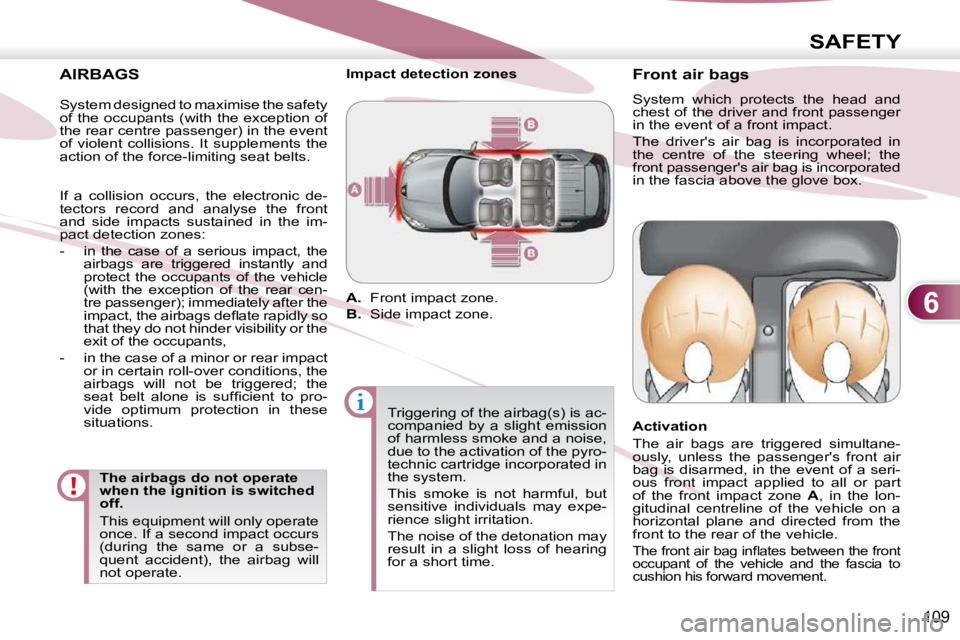
6
SAFETY
109
AIRBAGS The airbags do not operate
when the ignition is switched
off.
This equipment will only operate
once. If a second impact occurs
(during the same or a subse-
quent accident), the airbag will
not operate. Front air bags
System which protects the head and
chest of the driver and front passenger
in the event of a front impact.
The driver's air bag is incorporated in
the centre of the steering wheel; the
front passenger's air bag is incorporated
in the fascia above the glove box.
Activation
The air bags are triggered simultane-
ously, unless the passenger's front air
bag is disarmed, in the event of a seri-
ous front impact applied to all or part
of the front impact zone
A , in the lon-
gitudinal centreline of the vehicle on a
horizontal plane and directed from the
front to the rear of the vehicle.
�T�h�e� �f�r�o�n�t� �a�i�r� �b�a�g� �i�n�fl� �a�t�e�s� �b�e�t�w�e�e�n� �t�h�e� �f�r�o�n�t�
occupant of the vehicle and the fascia to
cushion his forward movement.
Impact detection zones
A. Front impact zone.
B. Side impact zone.
Triggering of the airbag(s) is ac-
companied by a slight emission
of harmless smoke and a noise,
due to the activation of the pyro-
technic cartridge incorporated in
the system.
This smoke is not harmful, but
sensitive individuals may expe-
rience slight irritation.
The noise of the detonation may
result in a slight loss of hearing
for a short time.
System designed to maximise the safety
of the occupants (with the exception of
the rear centre passenger) in the event
of violent collisions. It supplements the
action of the force-limiting seat belts.
If a collision occurs, the electronic de-
tectors record and analyse the front
and side impacts sustained in the im-
pact detection zones:
- in the case of a serious impact, the
airbags are triggered instantly and
protect the occupants of the vehicle
(with the exception of the rear cen-
tre passenger); immediately after the
�i�m�p�a�c�t�,� �t�h�e� �a�i�r�b�a�g�s� �d�e�fl� �a�t�e� �r�a�p�i�d�l�y� �s�o�
that they do not hinder visibility or the
exit of the occupants,
- in the case of a minor or rear impact or in certain roll-over conditions, the
airbags will not be triggered; the
�s�e�a�t� �b�e�l�t� �a�l�o�n�e� �i�s� �s�u�f�fi� �c�i�e�n�t� �t�o� �p�r�o�-
vide optimum protection in these
situations.
Page 119 of 230
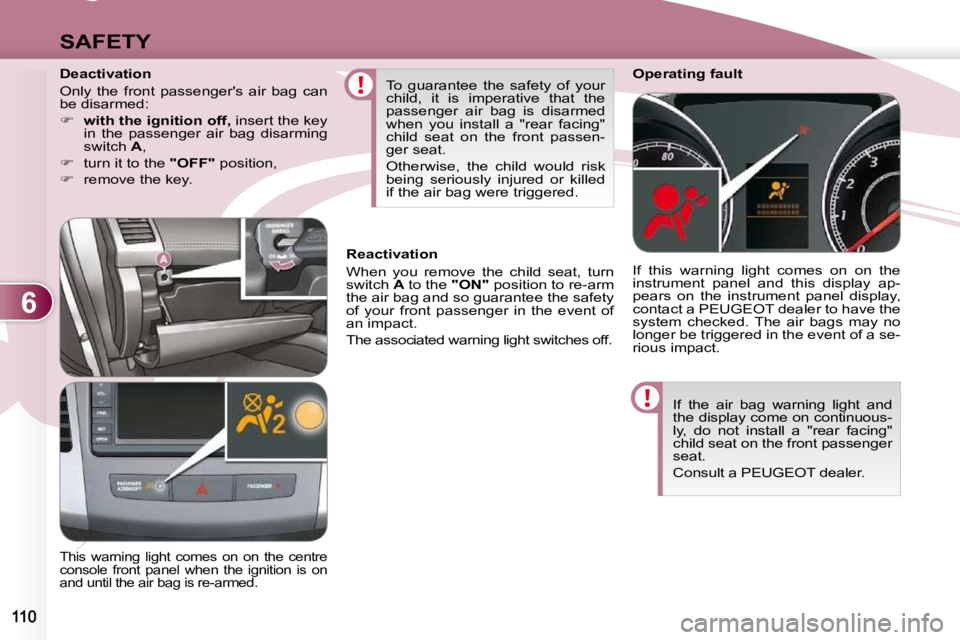
6
SAFETY
If the air bag warning light and
the display come on continuous-
ly, do not install a "rear facing"
child seat on the front passenger
seat.
Consult a PEUGEOT dealer.
Operating fault
If this warning light comes on on the
instrument panel and this display ap-
pears on the instrument panel display,
contact a PEUGEOT dealer to have the
system checked. The air bags may no
longer be triggered in the event of a se-
rious impact.
To guarantee the safety of your
child, it is imperative that the
passenger air bag is disarmed
when you install a "rear facing"
child seat on the front passen-
ger seat.
Otherwise, the child would risk
being seriously injured or killed
if the air bag were triggered.
This warning light comes on on the centre
console front panel when the ignition is on
and until the air bag is re-armed.
Reactivation
When you remove the child seat, turn
switch
A to the "ON" position to re-arm
the air bag and so guarantee the safety
of your front passenger in the event of
an impact.
The associated warning light switches off.
Deactivation
Only the front passenger's air bag can
be disarmed:
� with the ignition off , insert the key
in the passenger air bag disarming
switch A ,
� turn it to the "OFF" position,
� remove the key.
Page 120 of 230
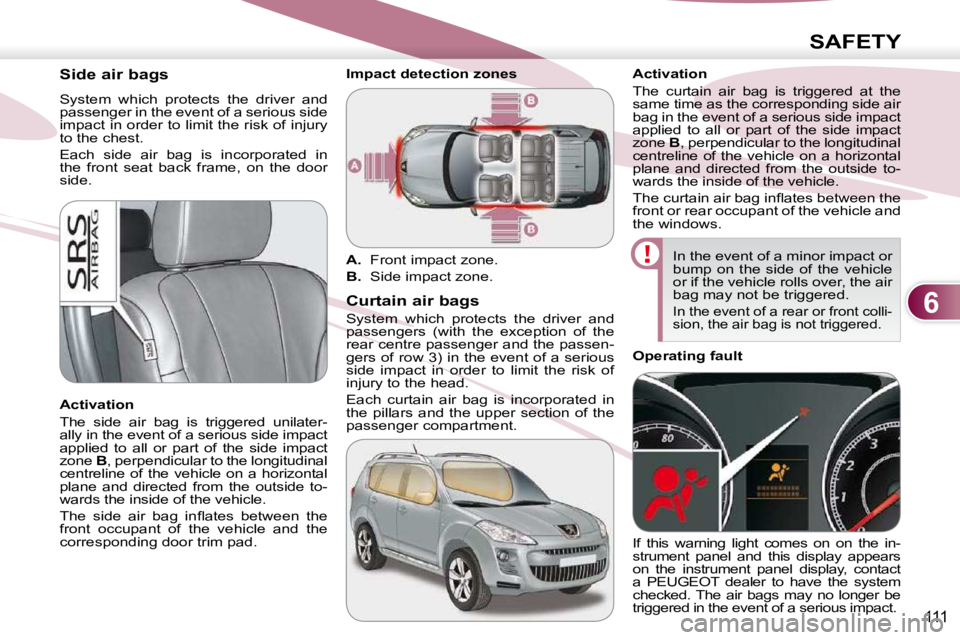
6
SAFETY
111
Side air bags
System which protects the driver and
passenger in the event of a serious side
impact in order to limit the risk of injury
to the chest.
Each side air bag is incorporated in
the front seat back frame, on the door
side.
Activation
The side air bag is triggered unilater-
ally in the event of a serious side impact
applied to all or part of the side impact
zone B , perpendicular to the longitudinal
centreline of the vehicle on a horizontal
plane and directed from the outside to-
wards the inside of the vehicle.
� �T�h�e� �s�i�d�e� �a�i�r� �b�a�g� �i�n�fl� �a�t�e�s� �b�e�t�w�e�e�n� �t�h�e�
front occupant of the vehicle and the
corresponding door trim pad. Curtain air bags
System which protects the driver and
passengers (with the exception of the
rear centre passenger and the passen-
gers of row 3) in the event of a serious
side impact in order to limit the risk of
injury to the head.
Each curtain air bag is incorporated in
the pillars and the upper section of the
passenger compartment. Activation
The curtain air bag is triggered at the
same time as the corresponding side air
bag in the event of a serious side impact
applied to all or part of the side impact
zone
B , perpendicular to the longitudinal
centreline of the vehicle on a horizontal
plane and directed from the outside to-
wards the inside of the vehicle.
� �T�h�e� �c�u�r�t�a�i�n� �a�i�r� �b�a�g� �i�n�fl� �a�t�e�s� �b�e�t�w�e�e�n� �t�h�e�
front or rear occupant of the vehicle and
the windows.
In the event of a minor impact or
bump on the side of the vehicle
or if the vehicle rolls over, the air
bag may not be triggered.
In the event of a rear or front colli-
sion, the air bag is not triggered.
Impact detection zones
A. Front impact zone.
B. Side impact zone.
Operating fault
If this warning light comes on on the in-
strument panel and this display appears
on the instrument panel display, contact
a PEUGEOT dealer to have the system
checked. The air bags may no longer be
triggered in the event of a serious impact.
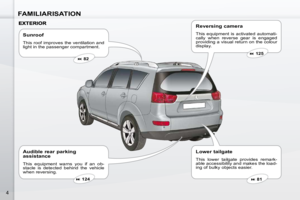 1
1 2
2 3
3 4
4 5
5 6
6 7
7 8
8 9
9 10
10 11
11 12
12 13
13 14
14 15
15 16
16 17
17 18
18 19
19 20
20 21
21 22
22 23
23 24
24 25
25 26
26 27
27 28
28 29
29 30
30 31
31 32
32 33
33 34
34 35
35 36
36 37
37 38
38 39
39 40
40 41
41 42
42 43
43 44
44 45
45 46
46 47
47 48
48 49
49 50
50 51
51 52
52 53
53 54
54 55
55 56
56 57
57 58
58 59
59 60
60 61
61 62
62 63
63 64
64 65
65 66
66 67
67 68
68 69
69 70
70 71
71 72
72 73
73 74
74 75
75 76
76 77
77 78
78 79
79 80
80 81
81 82
82 83
83 84
84 85
85 86
86 87
87 88
88 89
89 90
90 91
91 92
92 93
93 94
94 95
95 96
96 97
97 98
98 99
99 100
100 101
101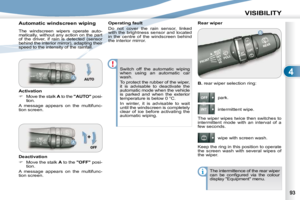 102
102 103
103 104
104 105
105 106
106 107
107 108
108 109
109 110
110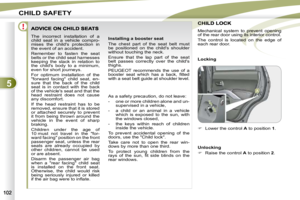 111
111 112
112 113
113 114
114 115
115 116
116 117
117 118
118 119
119 120
120 121
121 122
122 123
123 124
124 125
125 126
126 127
127 128
128 129
129 130
130 131
131 132
132 133
133 134
134 135
135 136
136 137
137 138
138 139
139 140
140 141
141 142
142 143
143 144
144 145
145 146
146 147
147 148
148 149
149 150
150 151
151 152
152 153
153 154
154 155
155 156
156 157
157 158
158 159
159 160
160 161
161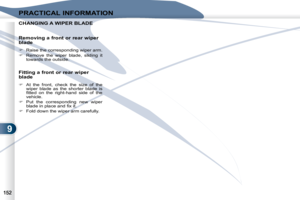 162
162 163
163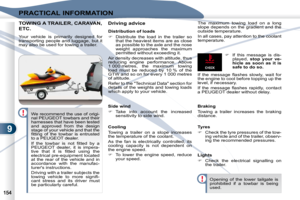 164
164 165
165 166
166 167
167 168
168 169
169 170
170 171
171 172
172 173
173 174
174 175
175 176
176 177
177 178
178 179
179 180
180 181
181 182
182 183
183 184
184 185
185 186
186 187
187 188
188 189
189 190
190 191
191 192
192 193
193 194
194 195
195 196
196 197
197 198
198 199
199 200
200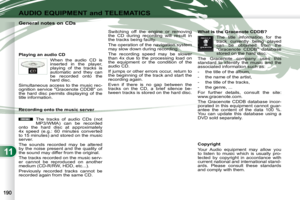 201
201 202
202 203
203 204
204 205
205 206
206 207
207 208
208 209
209 210
210 211
211 212
212 213
213 214
214 215
215 216
216 217
217 218
218 219
219 220
220 221
221 222
222 223
223 224
224 225
225 226
226 227
227 228
228 229
229






